University of Suffolk BABS: Essay on Business Decision Making
VerifiedAdded on 2023/06/14
|7
|1374
|366
Essay
AI Summary
This essay provides a comprehensive analysis of business decision-making, focusing on financial tools like Net Present Value (NPV) and Payback Period, along with the influence of financial and non-financial factors. It evaluates two projects, Project A (Smoothies) and Project B (Non-Dairy Milk), using these methods to determine the most viable option for an organization. The essay also discusses the importance of liquidity, the size of the entity, and valuation as financial considerations, alongside non-financial aspects like industry standards and relationships with customers and suppliers. Ultimately, the essay concludes that effective decision-making is crucial for organizational success, highlighting the need to consider both quantitative analysis and qualitative factors in project selection.

BUSINESS DECISION
MAKING
MAKING
Paraphrase This Document
Need a fresh take? Get an instant paraphrase of this document with our AI Paraphraser
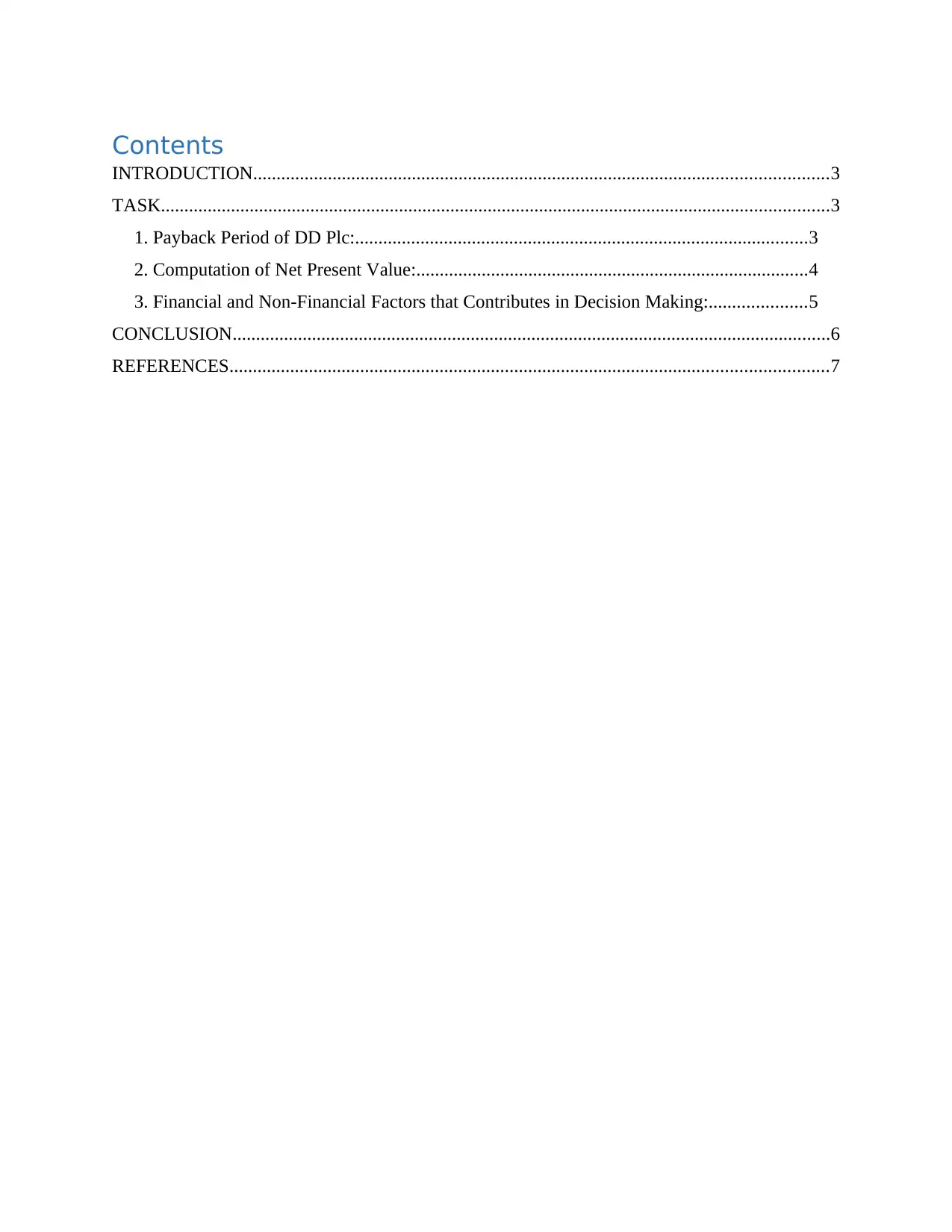
Contents
INTRODUCTION...........................................................................................................................3
TASK...............................................................................................................................................3
1. Payback Period of DD Plc:.................................................................................................3
2. Computation of Net Present Value:....................................................................................4
3. Financial and Non-Financial Factors that Contributes in Decision Making:.....................5
CONCLUSION................................................................................................................................6
REFERENCES................................................................................................................................7
INTRODUCTION...........................................................................................................................3
TASK...............................................................................................................................................3
1. Payback Period of DD Plc:.................................................................................................3
2. Computation of Net Present Value:....................................................................................4
3. Financial and Non-Financial Factors that Contributes in Decision Making:.....................5
CONCLUSION................................................................................................................................6
REFERENCES................................................................................................................................7

INTRODUCTION
Business decision making simply means considering best option for the desired projects
which are available that which one is better for the organisation (Poggensee and Poggensee,
2021). This can be decided by performing various financial test after taking into account
different methods such as Net present value, Payback period, internal rate of return, profitability
index etc. It is a defined procedure to select the alternate among various options available so that
best alternate is selected considering the needs of the organisation and the resource availability
they have.
TASK
1. Payback Period of DD Plc:
Payback period is a financial tool which helps in analysing the desirability of the project
the entity needs to take into account (Pradhan, Arvin, and Hall, 2019). This method helps the
business concern to evaluate that how much time the project will require to order to recover its
investment they make initially in the proposed project.
Calculation as under: -
Project A - Smoothies Project B - Non Dairy
Year Cash Flow Cumulative Cash
Flows
Cash Flow Cumulative Cash Flow
0 -158000 -158000 -155000 -155000
1 72000 -86000 71,000 -84000
2 78000 -8000 73,000 -11000
3 82000 74000 97,000 86000
4 110000 184000 118,000 32000
5 125000 309000 121,000 153000
`
Payback period of Project A
= 2 years + 8000 / 82000
= 2 years + 0.097
Business decision making simply means considering best option for the desired projects
which are available that which one is better for the organisation (Poggensee and Poggensee,
2021). This can be decided by performing various financial test after taking into account
different methods such as Net present value, Payback period, internal rate of return, profitability
index etc. It is a defined procedure to select the alternate among various options available so that
best alternate is selected considering the needs of the organisation and the resource availability
they have.
TASK
1. Payback Period of DD Plc:
Payback period is a financial tool which helps in analysing the desirability of the project
the entity needs to take into account (Pradhan, Arvin, and Hall, 2019). This method helps the
business concern to evaluate that how much time the project will require to order to recover its
investment they make initially in the proposed project.
Calculation as under: -
Project A - Smoothies Project B - Non Dairy
Year Cash Flow Cumulative Cash
Flows
Cash Flow Cumulative Cash Flow
0 -158000 -158000 -155000 -155000
1 72000 -86000 71,000 -84000
2 78000 -8000 73,000 -11000
3 82000 74000 97,000 86000
4 110000 184000 118,000 32000
5 125000 309000 121,000 153000
`
Payback period of Project A
= 2 years + 8000 / 82000
= 2 years + 0.097
⊘ This is a preview!⊘
Do you want full access?
Subscribe today to unlock all pages.

Trusted by 1+ million students worldwide
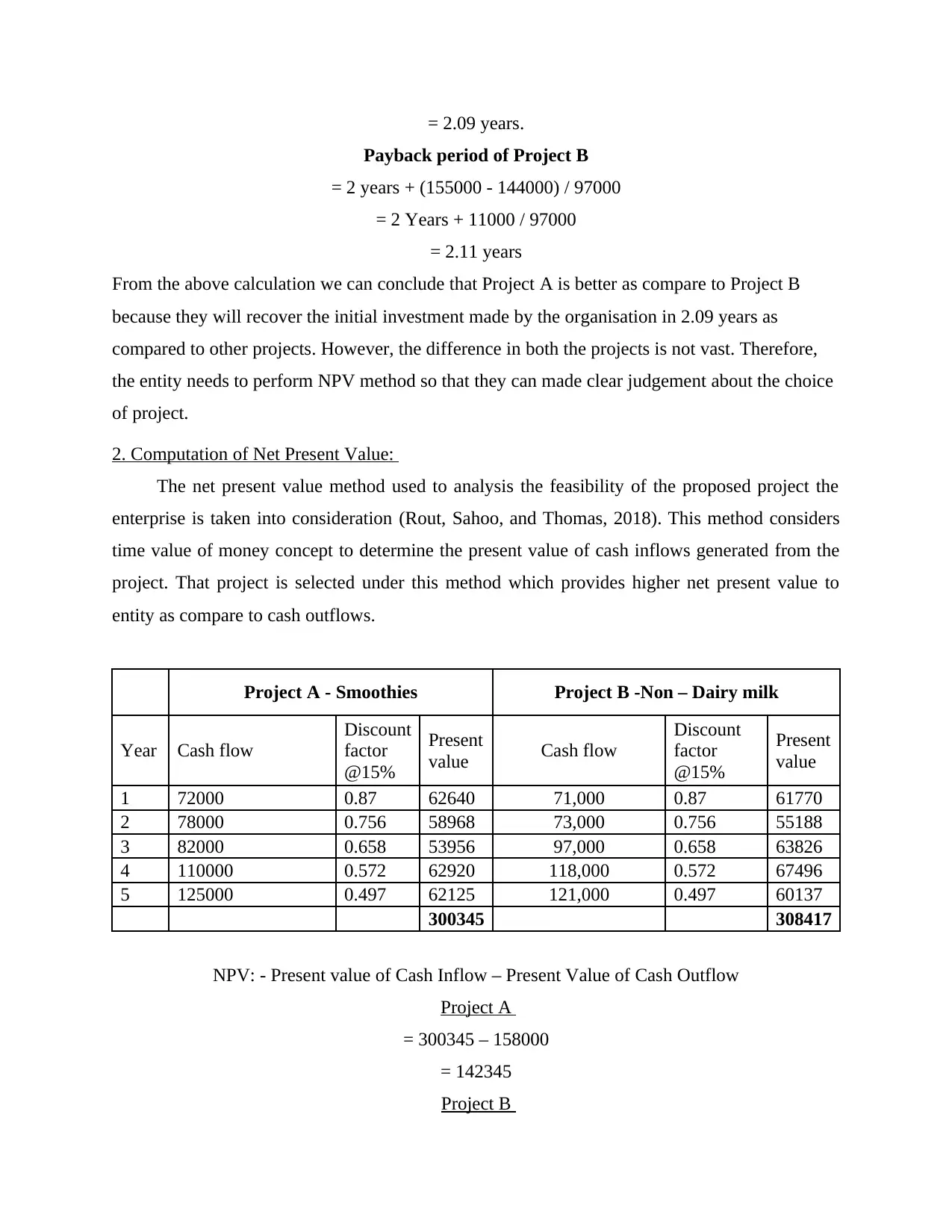
= 2.09 years.
Payback period of Project B
= 2 years + (155000 - 144000) / 97000
= 2 Years + 11000 / 97000
= 2.11 years
From the above calculation we can conclude that Project A is better as compare to Project B
because they will recover the initial investment made by the organisation in 2.09 years as
compared to other projects. However, the difference in both the projects is not vast. Therefore,
the entity needs to perform NPV method so that they can made clear judgement about the choice
of project.
2. Computation of Net Present Value:
The net present value method used to analysis the feasibility of the proposed project the
enterprise is taken into consideration (Rout, Sahoo, and Thomas, 2018). This method considers
time value of money concept to determine the present value of cash inflows generated from the
project. That project is selected under this method which provides higher net present value to
entity as compare to cash outflows.
Project A - Smoothies Project B -Non – Dairy milk
Year Cash flow
Discount
factor
@15%
Present
value Cash flow
Discount
factor
@15%
Present
value
1 72000 0.87 62640 71,000 0.87 61770
2 78000 0.756 58968 73,000 0.756 55188
3 82000 0.658 53956 97,000 0.658 63826
4 110000 0.572 62920 118,000 0.572 67496
5 125000 0.497 62125 121,000 0.497 60137
300345 308417
NPV: - Present value of Cash Inflow – Present Value of Cash Outflow
Project A
= 300345 – 158000
= 142345
Project B
Payback period of Project B
= 2 years + (155000 - 144000) / 97000
= 2 Years + 11000 / 97000
= 2.11 years
From the above calculation we can conclude that Project A is better as compare to Project B
because they will recover the initial investment made by the organisation in 2.09 years as
compared to other projects. However, the difference in both the projects is not vast. Therefore,
the entity needs to perform NPV method so that they can made clear judgement about the choice
of project.
2. Computation of Net Present Value:
The net present value method used to analysis the feasibility of the proposed project the
enterprise is taken into consideration (Rout, Sahoo, and Thomas, 2018). This method considers
time value of money concept to determine the present value of cash inflows generated from the
project. That project is selected under this method which provides higher net present value to
entity as compare to cash outflows.
Project A - Smoothies Project B -Non – Dairy milk
Year Cash flow
Discount
factor
@15%
Present
value Cash flow
Discount
factor
@15%
Present
value
1 72000 0.87 62640 71,000 0.87 61770
2 78000 0.756 58968 73,000 0.756 55188
3 82000 0.658 53956 97,000 0.658 63826
4 110000 0.572 62920 118,000 0.572 67496
5 125000 0.497 62125 121,000 0.497 60137
300345 308417
NPV: - Present value of Cash Inflow – Present Value of Cash Outflow
Project A
= 300345 – 158000
= 142345
Project B
Paraphrase This Document
Need a fresh take? Get an instant paraphrase of this document with our AI Paraphraser
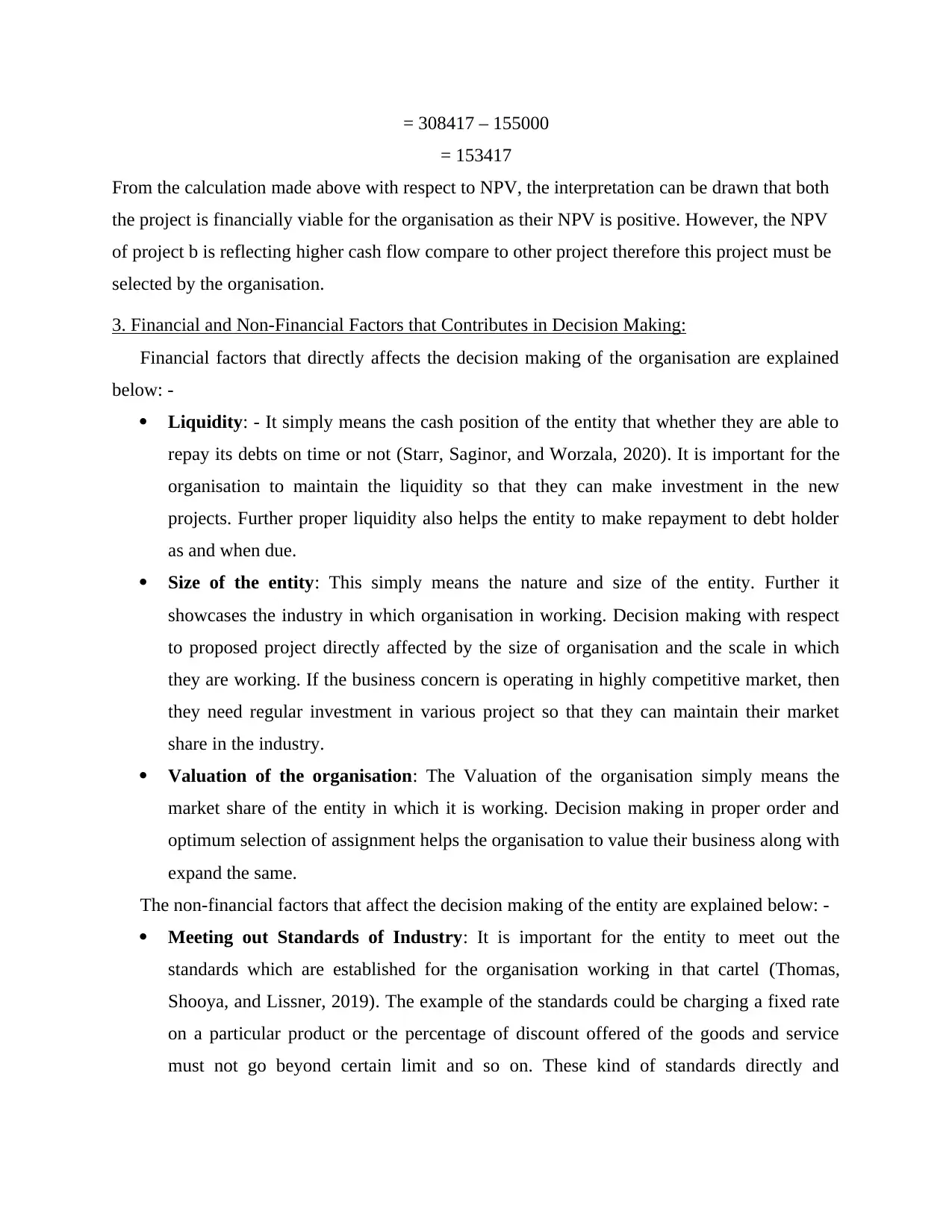
= 308417 – 155000
= 153417
From the calculation made above with respect to NPV, the interpretation can be drawn that both
the project is financially viable for the organisation as their NPV is positive. However, the NPV
of project b is reflecting higher cash flow compare to other project therefore this project must be
selected by the organisation.
3. Financial and Non-Financial Factors that Contributes in Decision Making:
Financial factors that directly affects the decision making of the organisation are explained
below: -
Liquidity: - It simply means the cash position of the entity that whether they are able to
repay its debts on time or not (Starr, Saginor, and Worzala, 2020). It is important for the
organisation to maintain the liquidity so that they can make investment in the new
projects. Further proper liquidity also helps the entity to make repayment to debt holder
as and when due.
Size of the entity: This simply means the nature and size of the entity. Further it
showcases the industry in which organisation in working. Decision making with respect
to proposed project directly affected by the size of organisation and the scale in which
they are working. If the business concern is operating in highly competitive market, then
they need regular investment in various project so that they can maintain their market
share in the industry.
Valuation of the organisation: The Valuation of the organisation simply means the
market share of the entity in which it is working. Decision making in proper order and
optimum selection of assignment helps the organisation to value their business along with
expand the same.
The non-financial factors that affect the decision making of the entity are explained below: -
Meeting out Standards of Industry: It is important for the entity to meet out the
standards which are established for the organisation working in that cartel (Thomas,
Shooya, and Lissner, 2019). The example of the standards could be charging a fixed rate
on a particular product or the percentage of discount offered of the goods and service
must not go beyond certain limit and so on. These kind of standards directly and
= 153417
From the calculation made above with respect to NPV, the interpretation can be drawn that both
the project is financially viable for the organisation as their NPV is positive. However, the NPV
of project b is reflecting higher cash flow compare to other project therefore this project must be
selected by the organisation.
3. Financial and Non-Financial Factors that Contributes in Decision Making:
Financial factors that directly affects the decision making of the organisation are explained
below: -
Liquidity: - It simply means the cash position of the entity that whether they are able to
repay its debts on time or not (Starr, Saginor, and Worzala, 2020). It is important for the
organisation to maintain the liquidity so that they can make investment in the new
projects. Further proper liquidity also helps the entity to make repayment to debt holder
as and when due.
Size of the entity: This simply means the nature and size of the entity. Further it
showcases the industry in which organisation in working. Decision making with respect
to proposed project directly affected by the size of organisation and the scale in which
they are working. If the business concern is operating in highly competitive market, then
they need regular investment in various project so that they can maintain their market
share in the industry.
Valuation of the organisation: The Valuation of the organisation simply means the
market share of the entity in which it is working. Decision making in proper order and
optimum selection of assignment helps the organisation to value their business along with
expand the same.
The non-financial factors that affect the decision making of the entity are explained below: -
Meeting out Standards of Industry: It is important for the entity to meet out the
standards which are established for the organisation working in that cartel (Thomas,
Shooya, and Lissner, 2019). The example of the standards could be charging a fixed rate
on a particular product or the percentage of discount offered of the goods and service
must not go beyond certain limit and so on. These kind of standards directly and
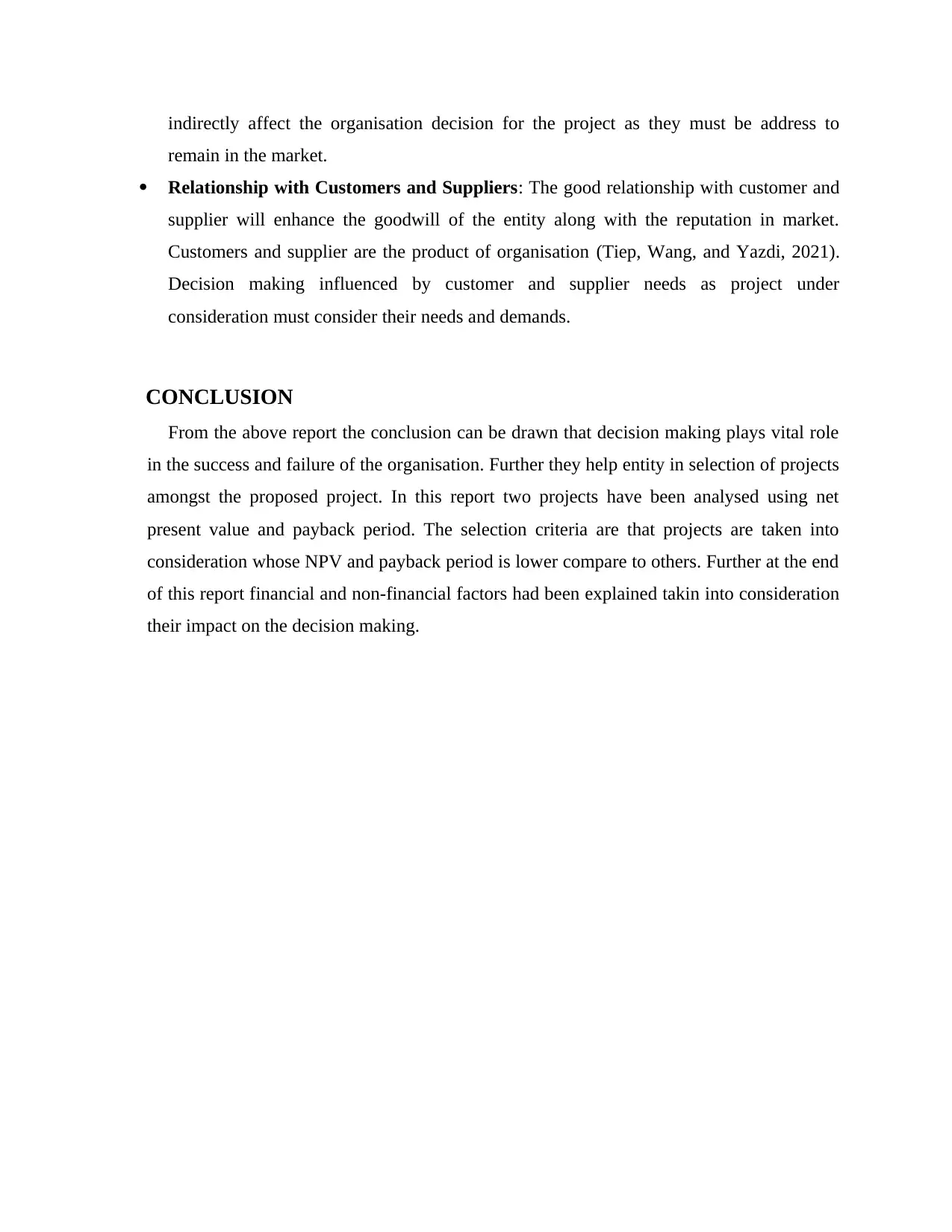
indirectly affect the organisation decision for the project as they must be address to
remain in the market.
Relationship with Customers and Suppliers: The good relationship with customer and
supplier will enhance the goodwill of the entity along with the reputation in market.
Customers and supplier are the product of organisation (Tiep, Wang, and Yazdi, 2021).
Decision making influenced by customer and supplier needs as project under
consideration must consider their needs and demands.
CONCLUSION
From the above report the conclusion can be drawn that decision making plays vital role
in the success and failure of the organisation. Further they help entity in selection of projects
amongst the proposed project. In this report two projects have been analysed using net
present value and payback period. The selection criteria are that projects are taken into
consideration whose NPV and payback period is lower compare to others. Further at the end
of this report financial and non-financial factors had been explained takin into consideration
their impact on the decision making.
remain in the market.
Relationship with Customers and Suppliers: The good relationship with customer and
supplier will enhance the goodwill of the entity along with the reputation in market.
Customers and supplier are the product of organisation (Tiep, Wang, and Yazdi, 2021).
Decision making influenced by customer and supplier needs as project under
consideration must consider their needs and demands.
CONCLUSION
From the above report the conclusion can be drawn that decision making plays vital role
in the success and failure of the organisation. Further they help entity in selection of projects
amongst the proposed project. In this report two projects have been analysed using net
present value and payback period. The selection criteria are that projects are taken into
consideration whose NPV and payback period is lower compare to others. Further at the end
of this report financial and non-financial factors had been explained takin into consideration
their impact on the decision making.
⊘ This is a preview!⊘
Do you want full access?
Subscribe today to unlock all pages.

Trusted by 1+ million students worldwide
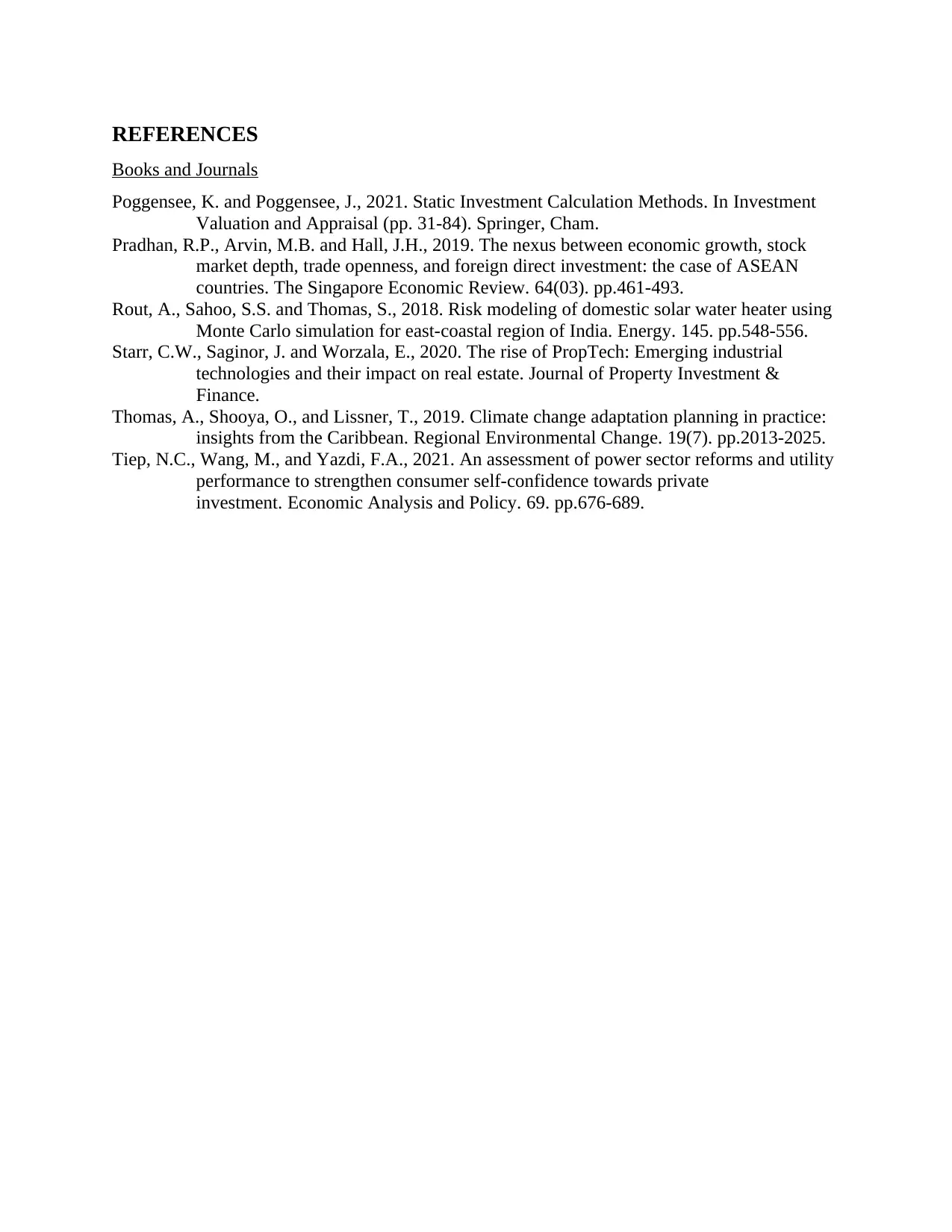
REFERENCES
Books and Journals
Poggensee, K. and Poggensee, J., 2021. Static Investment Calculation Methods. In Investment
Valuation and Appraisal (pp. 31-84). Springer, Cham.
Pradhan, R.P., Arvin, M.B. and Hall, J.H., 2019. The nexus between economic growth, stock
market depth, trade openness, and foreign direct investment: the case of ASEAN
countries. The Singapore Economic Review. 64(03). pp.461-493.
Rout, A., Sahoo, S.S. and Thomas, S., 2018. Risk modeling of domestic solar water heater using
Monte Carlo simulation for east-coastal region of India. Energy. 145. pp.548-556.
Starr, C.W., Saginor, J. and Worzala, E., 2020. The rise of PropTech: Emerging industrial
technologies and their impact on real estate. Journal of Property Investment &
Finance.
Thomas, A., Shooya, O., and Lissner, T., 2019. Climate change adaptation planning in practice:
insights from the Caribbean. Regional Environmental Change. 19(7). pp.2013-2025.
Tiep, N.C., Wang, M., and Yazdi, F.A., 2021. An assessment of power sector reforms and utility
performance to strengthen consumer self-confidence towards private
investment. Economic Analysis and Policy. 69. pp.676-689.
Books and Journals
Poggensee, K. and Poggensee, J., 2021. Static Investment Calculation Methods. In Investment
Valuation and Appraisal (pp. 31-84). Springer, Cham.
Pradhan, R.P., Arvin, M.B. and Hall, J.H., 2019. The nexus between economic growth, stock
market depth, trade openness, and foreign direct investment: the case of ASEAN
countries. The Singapore Economic Review. 64(03). pp.461-493.
Rout, A., Sahoo, S.S. and Thomas, S., 2018. Risk modeling of domestic solar water heater using
Monte Carlo simulation for east-coastal region of India. Energy. 145. pp.548-556.
Starr, C.W., Saginor, J. and Worzala, E., 2020. The rise of PropTech: Emerging industrial
technologies and their impact on real estate. Journal of Property Investment &
Finance.
Thomas, A., Shooya, O., and Lissner, T., 2019. Climate change adaptation planning in practice:
insights from the Caribbean. Regional Environmental Change. 19(7). pp.2013-2025.
Tiep, N.C., Wang, M., and Yazdi, F.A., 2021. An assessment of power sector reforms and utility
performance to strengthen consumer self-confidence towards private
investment. Economic Analysis and Policy. 69. pp.676-689.
1 out of 7
Related Documents
Your All-in-One AI-Powered Toolkit for Academic Success.
+13062052269
info@desklib.com
Available 24*7 on WhatsApp / Email
![[object Object]](/_next/static/media/star-bottom.7253800d.svg)
Unlock your academic potential
Copyright © 2020–2025 A2Z Services. All Rights Reserved. Developed and managed by ZUCOL.



